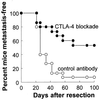Elimination of residual metastatic prostate cancer after surgery and adjunctive cytotoxic T lymphocyte-associated antigen 4 (CTLA-4) blockade immunotherapy
- PMID: 10611340
- PMCID: PMC24775
- DOI: 10.1073/pnas.96.26.15074
Elimination of residual metastatic prostate cancer after surgery and adjunctive cytotoxic T lymphocyte-associated antigen 4 (CTLA-4) blockade immunotherapy
Abstract
Cancer relapse after surgery is a common occurrence, most frequently resulting from the outgrowth of minimal residual disease in the form of metastases. We examined the effectiveness of cytotoxic T lymphocyte-associated antigen 4 (CTLA-4) blockade as an adjunctive immunotherapy to reduce metastatic relapse after primary prostate tumor resection. For these studies, we developed a murine model in which overt metastatic outgrowth of TRAMP-C2 (C2) prostate cancer ensues after complete primary tumor resection. Metastatic relapse in this model occurs reliably and principally within the draining lymph nodes in close proximity to the primary tumor, arising from established metastases present at the time of surgery. Using this model, we demonstrate that adjunctive CTLA-4 blockade administered immediately after primary tumor resection reduces metastatic relapse from 97.4 to 44%. Consistent with this, lymph nodes obtained 2 weeks after treatment reveal marked destruction or complete elimination of C2 metastases in 60% of mice receiving adjunctive anti-CTLA-4 whereas 100% of control antibody-treated mice demonstrate progressive C2 lymph node replacement. Our study demonstrates the potential of adjunctive CTLA-4 blockade immunotherapy to reduce cancer relapse emanating from minimal residual metastatic disease and may have broader implications for improving the capability of immunotherapy by combining such forms of therapy with other cytoreductive measures including surgery.
Figures




References
Publication types
MeSH terms
Substances
Grants and funding
LinkOut - more resources
Full Text Sources
Other Literature Sources
Medical
Molecular Biology Databases
Miscellaneous

